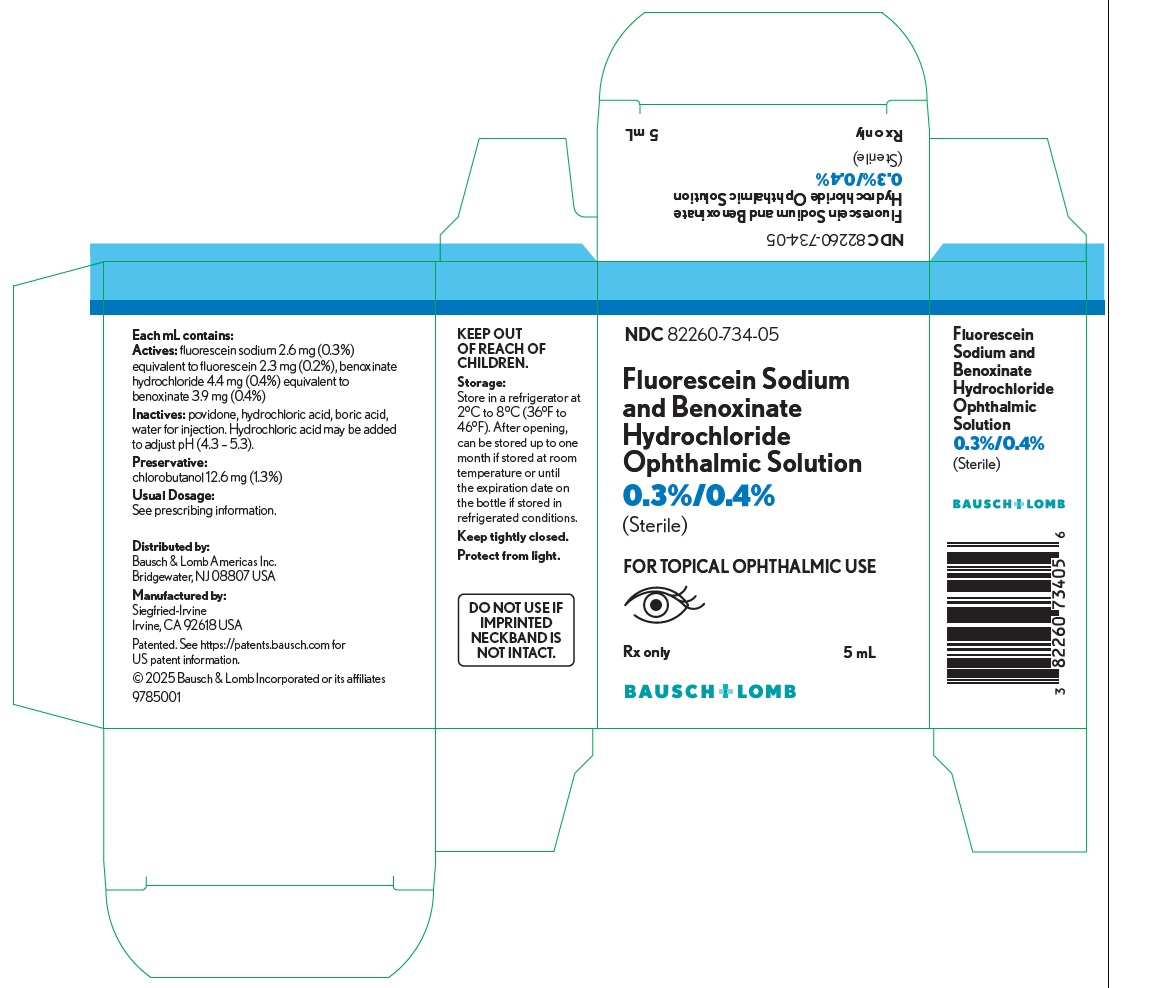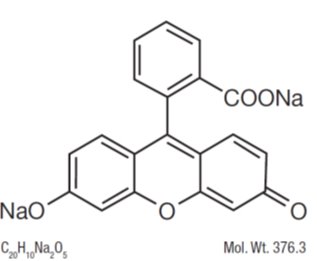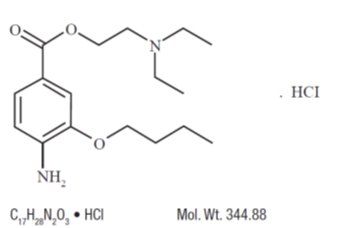Fluorescein Sodium and Benoxinate Hydrochloride
These highlights do not include all the information needed to use FLUORESCEIN SODIUM AND BENOXINATE HYDROCHLORIDE OPHTHALMIC SOLUTION, 0.3%/0.4% safely and effectively. See full prescribing information for FLUORESCEIN SODIUM AND BENOXINATE HYDROCHLORIDE OPHTHALMIC SOLUTION, 0.3%/0.4%. FLUORESCEIN SODIUM AND BENOXINATE HYDROCHLORIDE OPHTHALMIC SOLUTION, 0.3%/0.4%, for topical ophthalmic use Initial U.S. Approval: 2017
f935b5f8-dc6e-4425-a668-968ee3855f51
HUMAN PRESCRIPTION DRUG LABEL
Mar 16, 2023
Bausch & Lomb Americas Inc.
DUNS: 118287629
Products 1
Detailed information about drug products covered under this FDA approval, including NDC codes, dosage forms, ingredients, and administration routes.
Fluorescein Sodium and Benoxinate Hydrochloride
Product Details
FDA regulatory identification and product classification information
FDA Identifiers
Product Classification
Product Specifications
INGREDIENTS (5)
Drug Labeling Information
PACKAGE LABEL.PRINCIPAL DISPLAY PANEL
PACKAGE/LABEL PRINCIPAL DISPLAY PANEL
NDC82260-734-05
Fluorescein Sodium
and Benoxinate
Hydrochloride
Ophthalmic Solution
0.3%/0.4%
(Sterile)
FOR TOPICAL OPHTHALMIC USE
[Eye Image]
Rx only****5 mL
BAUSCH + LOMB
9785001

WARNINGS AND PRECAUTIONS SECTION
5 WARNINGS AND PRECAUTIONS
5.1 Corneal Toxicity
Prolonged use or abuse may lead to corneal epithelial toxicity and may manifest as epithelial defects which may progress to permanent corneal damage with accompanying visual loss.
5.2 Corneal Injury Due to Insensitivity
Patients should not touch the eye for approximately 20 minutes after using this anesthetic as accidental injuries can occur due to insensitivity of the eye.
- Corneal Toxicity: Prolonged use or abuse may lead to corneal epithelial toxicity and manifest as epithelial defects which may progress to permanent corneal damage. (Error! Hyperlink reference not valid.)
- Corneal Injury: Patients should not touch the eye for approximately 20 minutes after using anesthetic as accidental injuries can occur due to insensitivity of the eye. ( 5.2)
ADVERSE REACTIONS SECTION
6 ADVERSE REACTIONS
The following serious ocular adverse reactions are described elsewhere in the labeling:
- Corneal Toxicity [see Warnings and Precautions (5.1)]
- Corneal Injury Due to Insensitivity [see Warnings and Precautions (5.2)]
The following adverse reactions have been identified following use of Fluorescein Sodium and Benoxinate Hydrochloride Ophthalmic Solution, 0.3%/0.4%: ocular hyperemia, burning, stinging, eye irritation, blurred vision and punctate keratitis. Because these reactions are reported voluntarily from a population of uncertain size, it is not always possible to reliably estimate their frequency or establish a causal relationship to drug exposure.
The most common ocular adverse events are stinging, burning and conjunctival redness. ( 6)
**To report SUSPECTED ADVERSE REACTIONS, contact Bausch & Lomb Incorporated at 1-800-553-5340 or FDA at 1-800-FDA-1088 or **www.fda.gov/medwatch.
NONCLINICAL TOXICOLOGY SECTION
13 NONCLINICAL TOXICOLOGY
13.1 Carcinogenesis, Mutagenesis, Impairment of Fertility
Studies to evaluate the mutagenic or carcinogenic potential of Fluorescein Sodium and Benoxinate Hydrochloride Ophthalmic Solution, 0.3%/0.4% have not been conducted. Studies to evaluate impairment of fertility have not been conducted.
USE IN SPECIFIC POPULATIONS SECTION
8 USE IN SPECIFIC POPULATIONS
8.1 Pregnancy
Risk Summary
There are no available data on the use of Fluorescein Sodium and Benoxinate Hydrochloride Ophthalmic Solution, 0.3%/0.4% in pregnant women to inform any drug associated risk.
Adequate animal reproduction studies have not been conducted with fluorescein sodium and/or benoxinate hydrochloride. Fluorescein Sodium and Benoxinate Hydrochloride Ophthalmic Solution, 0.3%/0.4% should be given to a pregnant woman only if clearly needed.
8.2 Lactation
Risk Summary
There are no data on the presence of fluorescein sodium or benoxinate hydrochloride in human milk after ocular administration of Fluorescein Sodium and Benoxinate Hydrochloride Ophthalmic Solution, 0.3%/0.4%, the effects on the breastfed infant, or the effects on milk production.
The developmental and health benefits of breastfeeding should be considered, along with the mother’s clinical need for Fluorescein Sodium and Benoxinate Hydrochloride Ophthalmic Solution, 0.3%/0.4%, and any potential adverse effects on the breastfed infant from Fluorescein Sodium and Benoxinate Hydrochloride Ophthalmic Solution, 0.3%/0.4%.
8.4 Pediatric Use
The safety and effectiveness of Fluorescein Sodium and Benoxinate Hydrochloride Ophthalmic Solution, 0.3%/0.4% have been established for pediatric patients. Use of Fluorescein Sodium and Benoxinate Hydrochloride Ophthalmic Solution, 0.3%/0.4% is supported in pediatric patients by evidence from adequate and well controlled studies.
8.5 Geriatric Use
No overall differences in safety or effectiveness have been observed between elderly and younger patients.
DESCRIPTION SECTION
11 DESCRIPTION
Fluorescein Sodium and Benoxinate Hydrochloride Ophthalmic Solution, 0.3%/0.4% is a sterile solution containing a disclosing agent in combination with a short-acting ester anesthetic for topical ophthalmic use.
Fluorescein sodium is represented by the following structural formula:

Chemical Name: 3’,6’ Dihydroxy-3H-spiro[isobenzofuran-1,9-xanthen]-3-one disodium salt.
Benoxinate hydrochloride is represented by the following structural formula:

Chemical Name: 2-(Diethylamino) ethyl 4-amino-3-butoxybenzoate hydrochloride.
Each mL of Fluorescein Sodium and Benoxinate Hydrochloride Ophthalmic Solution 0.3%/0.4% contains:
- Active ingredients:fluorescein sodium 2.6 mg (0.3%) equivalent to fluorescein 2.3 mg (0.2%), benoxinate hydrochloride 4.4 mg (0.4%) equivalent to benoxinate 3.9 mg (0.4%)
- Preservative:chlorobutanol 12.6 mg (1.3%)
- Inactive ingredients:povidone, hydrochloric acid, boric acid, water for injection. Hydrochloric acid may be added to adjust pH (4.3 – 5.3).
INFORMATION FOR PATIENTS SECTION
17 PATIENT COUNSELING INFORMATION
Accidental Injury Precaution
Advise patients not to touch their eyes for approximately 20 minutes after application. Their eyes will be insensitive due to the effect of the anesthetic, and care should be taken to avoid accidental injuries.
Distributed by:
Bausch & Lomb Americas Inc.
Bridgewater, NJ 08807 USA
Manufactured by:
Siegfried-Irvine
Irvine, CA 92618 USA
Patented. See https://patents.bausch.comfor US patent information.
© 2022 Bausch & Lomb Incorporated or its affiliates
9785200
